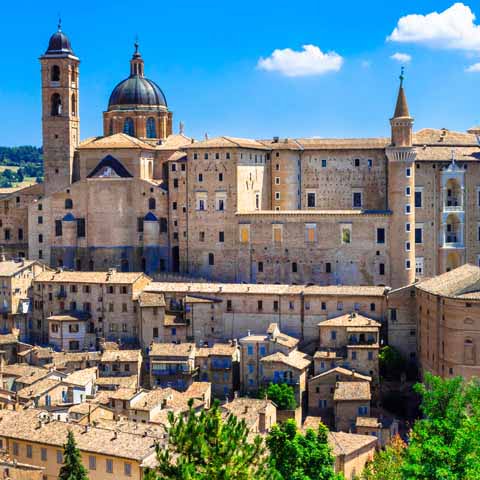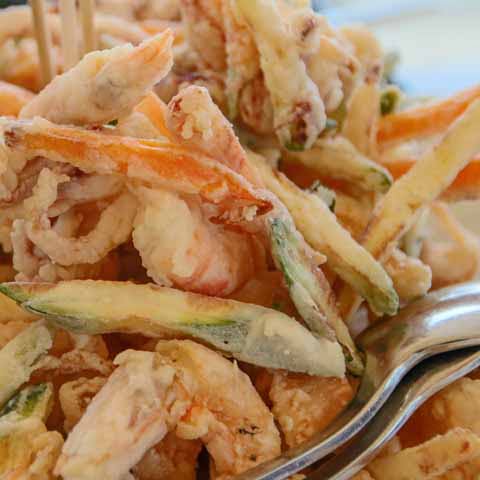Home of the famed artist Raphael and once a historic epicenter for artistic expression, the city of Urbino offers a wealth of unique cultural and sightseeing experiences for travelers. As a UNESCO World Heritage Site, it captures a historic time in Italy – the Renaissance – and preserves it for modern-day visitors to soak up. From unique architecture to local cuisine to museums with historic artifacts, travelers will have plenty to see and do while in Urbino.
FESTIVALS & EVENTS
The town’s biggest annual celebration occurs on June 1, which is the Feast Day of San Crescentino, Urbino’s patron saint. The locals celebrate San Crescentino with an evocative procession through the streets of Urbino’s historic city center featuring a statue of the saint.
One of Urbino’s annual festivals is the Festa dell’aquilone. Held every year in September since the 1950s, this event is a kite race. Each of the contrade, or neighborhoods, of the town has a representative and they battle to see whose kite can fly the furthest and highest.
Another fun event to see is the Festa del Duca. This festival takes visitors on a time-traveling journey back to the Middle Ages. There is a variety of medieval fun to be had, including a parade of costumed locals and a jousting tournament reenactment.
Urbino is also known for two music festivals, Festa Internazionale di Musica Antica (the International Festival of Ancient Music) and the Jazz Festival, which take place in July and August, respectively.
During the spring, one week is dedicated to Urbino’s most famous citizen: Raphael. The event consists of lectures, workshops, and exhibitions that celebrate the famed Renaissance painter.
Food lovers will not want to miss the Festival della Casciotta d’Urbino, an event dedicated to Urbino’s most beloved local cheese, which occurs in the late spring.
In nearby Fermignano, travelers can enjoy the annual Palio della Rana. Held on the Sunday after Easter, the unique event is a street race which features people in sixteenth-century outfits running while pushing carts. Each racer’s cart has a frog atop it.
Throughout the race, as frogs jump off their cart, the racers must stop to place the frog back in its spot before continuing to run. In addition to the race itself, the event features an array of festive local foods. A lively, funny, and entertaining event, the Palio della Rana is truly one of a kind.
OUTDOOR ACTIVITIES
If hoping to enjoy some time outdoors in Urbino, a beautiful site to see is the Orto Botanico, or Botanical Garden. This garden is bursting with a variety of plants and flowers – many of them unique and rare. The garden is walled and features ample shade for travelers who wish to stay out of the sun. Originally shared with the San Francesco Convent, the Botanical Garden dates back to the nineteenth century and covers nearly 24,000 square feet.
The city itself is characterized by its hilly geography, so the area is great for those who want to experience landscape walks. Be aware – the paths may be steep, but the views are worth it. For instance, some travelers may wish to make the uphill climb to Urbino’s historic Fortezza Albornoz, a medieval fortress that watches over the city and offers stunning views of the surrounding area.
Many travelers like to stay in Urbino while experiencing the outdoors of the neighboring towns. Villages located throughout the Marche region are known for their spectacular landscape of hills and mountains.
INDOOR ACTIVITIES
To enjoy time indoors, Urbino offers a variety of stunning architectural sites such as churches and indoor experiences like museums.
One of the must-see buildings in Urbino is the Cathedral. The Duomo di Urbino was rebuilt in the nineteenth century, so its white façade is unique compared to the other structures nearby, which are primarily made of red and brown brick. However, the best part of the Cathedral is its stunning interior, which features ornate details. The cathedral also features an underground Oratory that consists of three chapels decorated with marble sculptures and rich architectural details such as barrel vaults.
Not to be missed during a visit to the Cathedral is the Museo Diocesano Albani, which contains religious paintings, artifacts, and manuscripts.
Perhaps Urbino’s most stunning and largest site to explore is the sprawling Palazzo Ducale – the massive ducal palace that overlooks the hills of the city. It is a key aspect of what earned Urbino status as a UNESCO World Heritage Site, as it is one of Italy’s most important monuments. Featuring towers, balconies, and many rooms, the palace is known for its ornate architecture and large size.
Much of the palace is occupied by the Galleria Nazionale delle Marche, Urbino’s most important museum. The museum features a varied collection of artworks. It includes paintings from the fourteenth to the seventeenth centuries, many of which were a part of Duke Federico’s personal collection. It is home to Piero della Francesca’s masterpieces Flagellation of Christ and Madonna di Senigallia as well as La Muta by Raphael, and The Resurrection by Titian. The museum also houses work by many other celebrated artists of the time, such as Antonio Alberti da Ferrara, Vicenzo Pagani, Luca della Robbia, and many more.
One of the city’s most unique museums is Mueso dei Gessi, or the Plaster Cast Museum. The collection features 41 molds of ancient sculptures from the fifth century BC to the Roman Imperial Age.
Another way to enjoy being indoors in Urbino is to explore the local cuisine, wine, and cocktails. Because the city is a university town, there are a variety of unique, lively bars as well as elegant restaurants and casual cafes. Historic restaurants featuring unique seasonal food and traditional local dishes will take travelers on a delicious journey through Urbino’s past and culture. Nightspots and dessert shops help round out the evening with unique local flavors.
SHOPPING
While in Urbino, travelers can purchase local food products at a number of small shops. The selection includes many DOC and DOP products such as cheeses, meats, wine, beer, honey, olive oil, truffles, and more.
UNIQUE EXPERIENCES
When visiting Urbino, one of the must-see locales is Raphael’s House. A truly unique experience, travelers can visit the home in which the legendary artist was born and grew up in. Built in the fifteenth century, the house has been made into a museum which features paintings, furniture, and more from the time, including what is believed to be one of Raphael’s earliest works of art.
Outside of the city center Urbino is the Church of San Bernardino degli Zoccolanti. It houses the tombs of Duke Federico da Montefelto and Guidobaldo, his son, who was the final Montefeltro Duke of Urbino. It was built in 1491 and features remarkable Renaissance architecture.
Just 30 minutes outside of Urbino is a town called Urbania. There, visitors can see the Chiesa dei Morti, a church which houses 18 mummies. They have been uniquely preserved due to a certain mold present in the area.
Internationally recognized as one of Italy’s most charming hilltop towns, Urbino is the undisputed gem of the Marche region. From exploring the Renaissance architecture to visiting the museums and admiring the lush, natural surroundings, a trip to Urbino leaves all who visit with memories that last a lifetime.
Travel Guides







